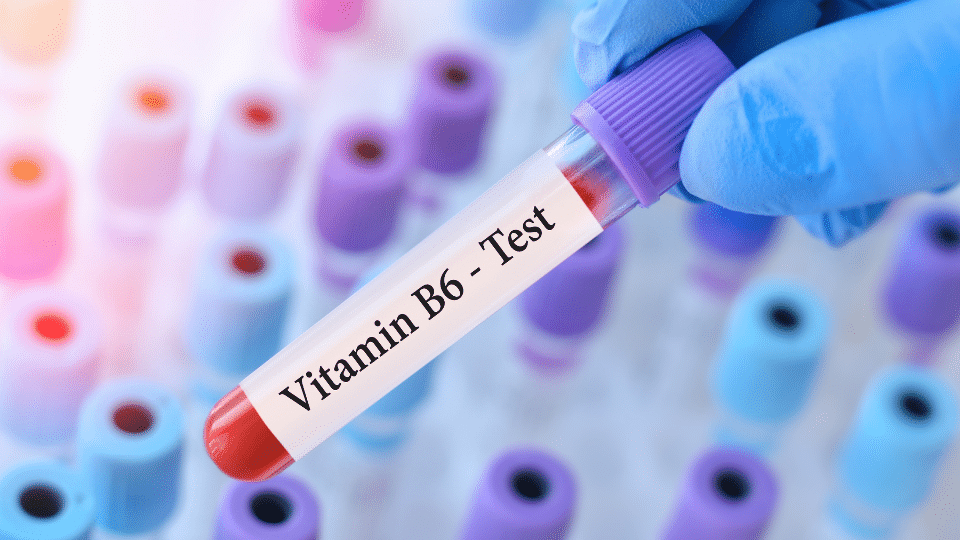- August 28, 2023
- By: Dr. Jamie Ahn
Low in Vitamin B6 & Zinc? Pyroluria Could be to Blame!
What is Pyroluria?
Pyroluria, also known as pyrrole disorder, is a metabolic condition characterized by an abnormal overproduction of pyrroles. Pyrroles are molecules produced during the creation of hemoglobin, the protein responsible for transporting oxygen in the blood.
Typically, pyrroles are harmlessly excreted in the urine.
However, in individuals with pyroluria, the excessive pyrroles have a high affinity for vitamin B6 (pyridoxine) and zinc, meaning the pyrroles bind tightly to vitamin B 6 and Zinc. When the pyrroles bind to these nutrients, they prevent the body from using it properly. This leads to a vitamin B 6 and Zinc deficiency.
Symptoms of Pyroluria
People with pyroluria may experience a range of physical, emotional, and cognitive symptoms because of the deficiencies.
While individual experiences can vary, the following descriptions provide an insight into what it might feel like to have pyroluria:
- Emotional and Mood Instability: Many individuals describe feeling frequent bouts of anxiety, irritability, or mood swings. This can feel like an emotional roller coaster, with unexpected changes in mood that seem uncontrollable.
- Stress Intolerance: Situations that others might find manageable could feel overwhelming to someone with pyroluria. They might find it hard to cope with daily stresses, feeling easily frustrated or defeated.
- Physical Fatigue: Despite getting adequate sleep, people with pyroluria often report feeling constantly tired or drained. This can make routine activities feel strenuous.
- Digestive Issues: Stomach upset, constipation, or other digestive issues might be frequent. This can result in discomfort after eating or a general reluctance towards certain foods.
- Sensory Sensitivities: Bright lights or loud noises might feel especially jarring. Such sensitivities can make environments like busy streets or crowded malls particularly challenging.
- Skin and Appearance: People might notice that their skin appears paler than usual or they don’t tan easily. Some may also develop stretch marks easily, even without significant weight changes.
- Joint Pain or Inflammation: There might be occasional or persistent joint pains, making activities that involve movement uncomfortable.
- Social Withdrawal: Due to the combination of symptoms, especially mood-related ones, individuals might prefer to avoid social situations. This can lead to feelings of isolation or depression.
- Cognitive Challenges: Some people report difficulties with memory or concentration. Tasks that require sustained attention or focus might feel more challenging.
- Sleep Disruptions: Despite feeling fatigued, some individuals with pyroluria might have trouble falling asleep or experience frequent awakenings during the night.
Remember, not every person with pyroluria will experience all of these symptoms, and the intensity can vary among individuals. It can depend on various factors, including the severity of the condition, coexisting health conditions, lifestyle factors, and personal coping mechanisms.
What Causes Pyroluria?
Some potential causes include:
- Genetics: Pyroluria can run in families, indicating a possible genetic component.
- Oxidative Stress: High levels of oxidative stress can increase pyrrole production. This can be due to various reasons, from chronic infections to exposure to environmental toxins (house hold products, personal care products, workplace environments, mold. etc).
- Dietary Deficiencies: A diet low in zinc or vitamin B6 can exacerbate the condition.
- Environmental Factors: Exposure to certain toxins or chronic stress may play a role in the onset or worsening of pyroluria.
- Poor Gut Health: It is very common in people with leaky gut, particularly after a lot of antibiotics.
How is Pyroluria Diagnosed in Functional Medicine?
In functional medicine the aim is to understand the entirety of a patient’s health profile rather than focusing solely on a specific condition.
Diagnosing pyroluria in a functional medicine setting involves a combination of clinical evaluation and laboratory testing:
- Detailed Patient History: A comprehensive medical, family, and lifestyle history is gathered. This can provide clues about potential nutrient deficiencies, stressors, or other factors that might suggest pyroluria. Common symptoms and factors related to pyroluria, such as anxiety, mood disorders, stress intolerance, and skin issues, would be explored in depth.
- Laboratory Testing: The most definitive diagnostic test for pyroluria is a urine test that measures kryptopyrrole or hydroxyhemopyrrolin-2-one (HPL) levels. Elevated levels of these pyrroles in urine are indicative of pyroluria.
- We may also test for related nutritional deficiencies, particularly zinc and vitamin B6 levels, to get a more comprehensive understanding of the patient’s nutrient status.
- Symptom Correlation: While laboratory tests are essential, functional medicine practitioners will also look for a correlation between the test results and the symptoms presented by the patient.
- For instance, if a patient has elevated pyrrole levels but none of the typical symptoms of pyroluria, the functional medicine practitioner might explore other potential causes or contributing factors.
- Other Relevant Tests: We might also recommend other tests to understand the broader health context. This could include assessments for gut health, hormonal balance, heavy metal toxicity, or other factors that might be relevant to the individual’s health.
- Re-testing: Periodic monitoring of pyrrole levels and related nutrient levels can be part of the diagnostic journey, especially when gauging response to treatments.
The diagnosis of pyroluria in functional medicine is not just about identifying elevated pyrrole levels, but understanding the patient’s broader health landscape and how pyroluria fits into it.
This comprehensive approach ensures that treatment strategies are tailored to the individual, addressing both the immediate concerns related to pyroluria and any underlying or associated health issues.
How to Treat Pyroluria
Treatment for pyroluria typically involves addressing the nutrient deficiencies it causes:
- Supplementation: The mainstay of treatment is supplementation with vitamin B6 and zinc. The exact dose can vary based on individual needs and should be determined under the guidance of a healthcare professional.
- Dietary Changes: A diet rich in foods containing zinc (like pumpkin seeds, beef, and chickpeas) and vitamin B6 (like poultry, fish, and bananas) can be beneficial. However, dietary recommendations are unique to each individual based on everything that comes up on their lab testing results.
- Stress Management: Given that stress can exacerbate symptoms, stress-reducing techniques such as mindfulness, meditation, and exercise can be helpful.
- Avoiding Alcohol and Caffeine: Both can further deplete zinc and vitamin B6 levels, contributing to symptoms.
Book A Consultation Call Today
Are you experiencing symptoms that may be linked to Pyroluria or another underlying health concern? Don’t leave your well-being to chance. Schedule an appointment with Dr. Jamie Ahn from Norwalk, CT, and embark on a journey towards balanced health. Let’s uncover and address the root causes together.

